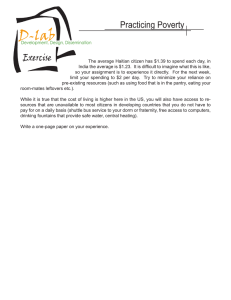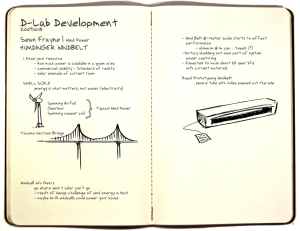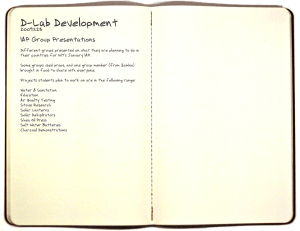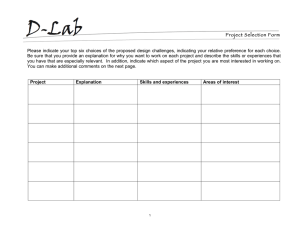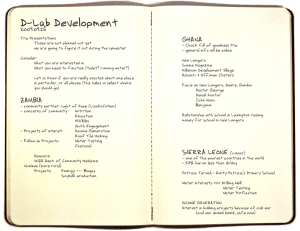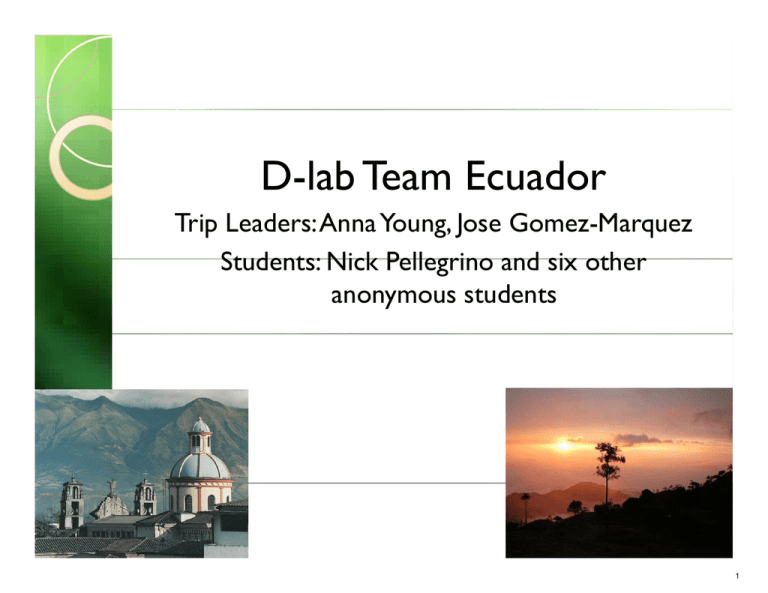
D-lab
D
lab Team Ecuador
Trip Leaders:Anna Young, Jose Gomez-Marquez
Students: Nick Pellegrino and six other
anonymous students
1
Qualitative Needs Assessment
•D-Lab’s
•We
first trip to Ecuador!
hope to:
•Identify projects for both D-Lab and D-Lab Health
•Through:
•Group assessments
•Individual interviews
•Emphasis
•Both
on participatory survey
an asset-based and a needs-based assessment
2
IT Projects
y
Deploying
p y g software to facilitate education
◦ Emphasizing the creative process
y
Introducing programming to computer
students
◦ Past background is in using programs, not
changing/creating them
3
Hydroponics
• Problem addressed
x Poor community health
• Hydroponic Systems
x No soil
soil, low cost,
cost little
land
profitable vegetables
easier
x Teach the technology to
partners
• Project
j
Goals
x Improve health through
increase in vegetable
i t k
intake
x Aid city microenterprise
byy makingg ggrowth of
© Dave's Hydroponics Experiments (http://www.dbcourt.co.uk/hydroponics/index.html).
All rights reserved. This content is excluded from our Creative Commons license.
For more information, see http://ocw.mit.edu/fairuse.
4
Encouraging
g g Design
g Through
g
Hydroponics Assembly
•Educational
Program
•Provide kits for building hydroponics systems
•Encourage students to change design to match their
•Encourage
home
•Determine
Determine effectiveness through contact with partners
partner
•Goal for Impact
•Students
Students gain
gain confidence
confidence designing for their community
•Program will continue after we leave
•Provide a base for similar future D-Lab
projects
5
Background on MEDIK Project
Identified
Problem:
•Mostt medical
•M
di l
equipment is
donated
•80% of donated
equipment fails
because of lack of
user knowledge
and maintenance
•D-lab Health
team 2009 found
centrifuges major
limiting factor
Work So Far:
Plan for IAP
•Turn the tables:
instead of MIT
students design, the
users design
•MEDIK project
gives
i
hhealthcare
lh
workers tools to
innovate and
maintain
•6 kits taught
through class in
Nicaragua
•Begin a new program
in Ecuador
•Set up class and
workshop to work
with microfluidics and
di
diagnostics
i
•Identify both urban
and rural partners
g
to
•Tailor pprogram
different situations
•Modify kits to meet
specific needs of
partners
6
Turn concepts into
building blocks
Test Read
out
Chemical
test
Sample
entry
Conceptualize the
Technology
Chemical
test and test
read out
Sample
entry
Different options to create
different systems:
multiple/different
lti l /diff
t ttests,
t
sensors
7
Ensuring Reliable Water Sources
Right Now in Ecuador:
-In most areas: piped water is either unavailable or contaminated and
unsafe
- Not enough water available to support hydroponic systems
To Do:
- Design household rainwater collection and purification systems
- Identify
Id if diff
different llevels
l off water needs
d and
d iintegration
i iinto their
h i
environments
- Analyze water quality and safety conditions through testing
8
MIT OpenCourseWare
http://ocw.mit.edu
EC.701J / 11.025J / 11.472J D-Lab I: Development
Fall 2009
For information about citing these materials or our Terms of Use, visit: http://ocw.mit.edu/terms.

